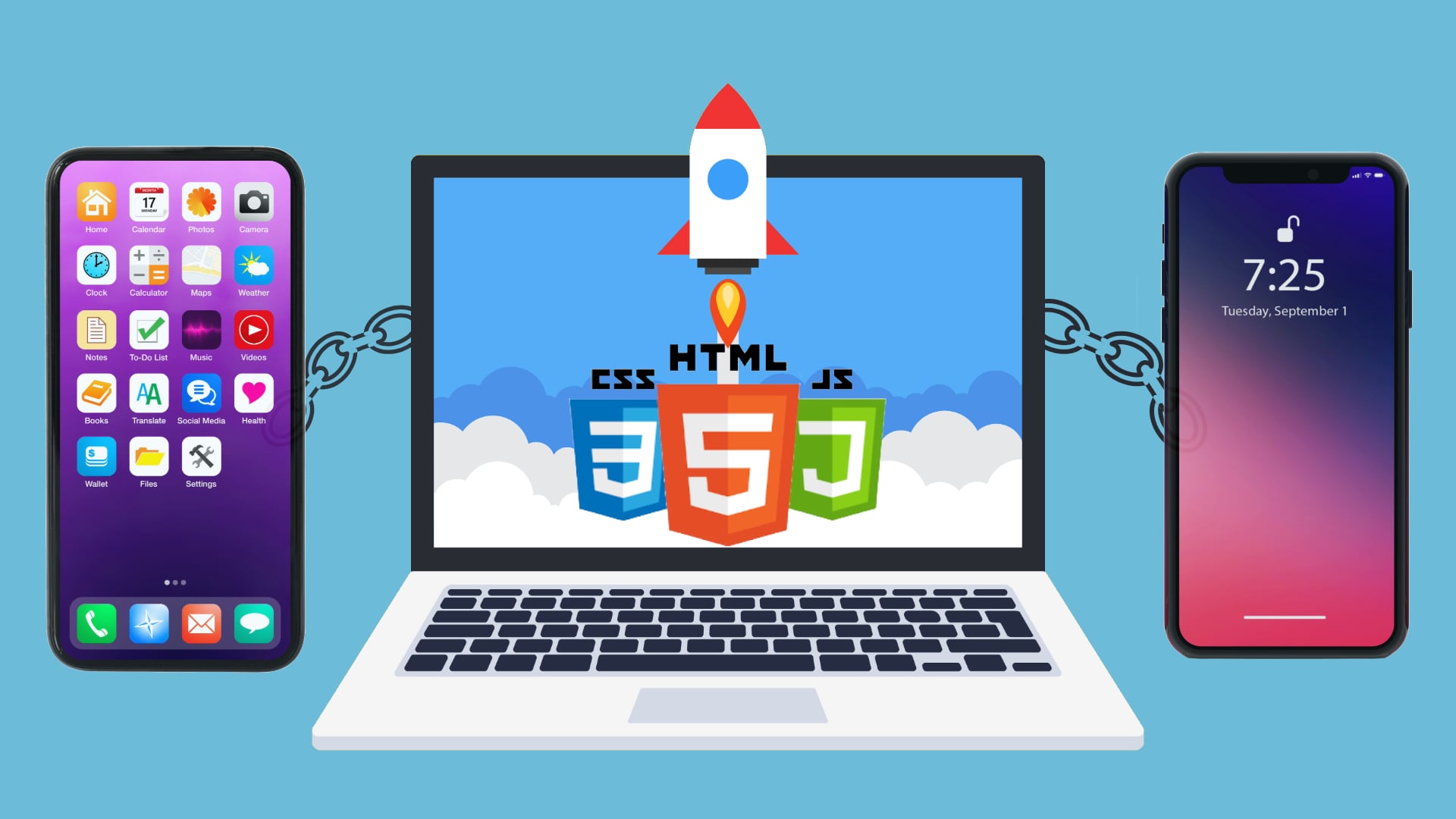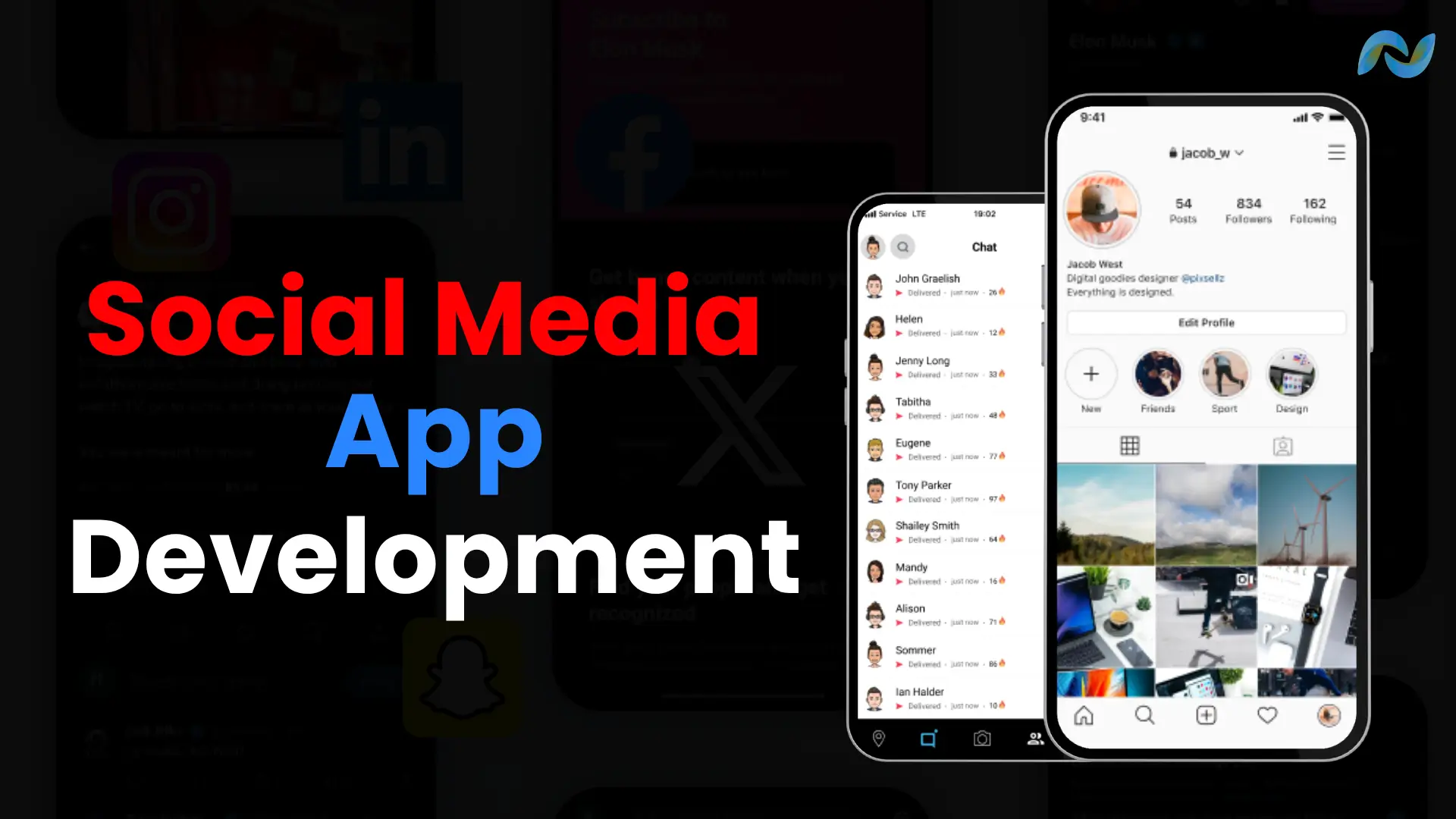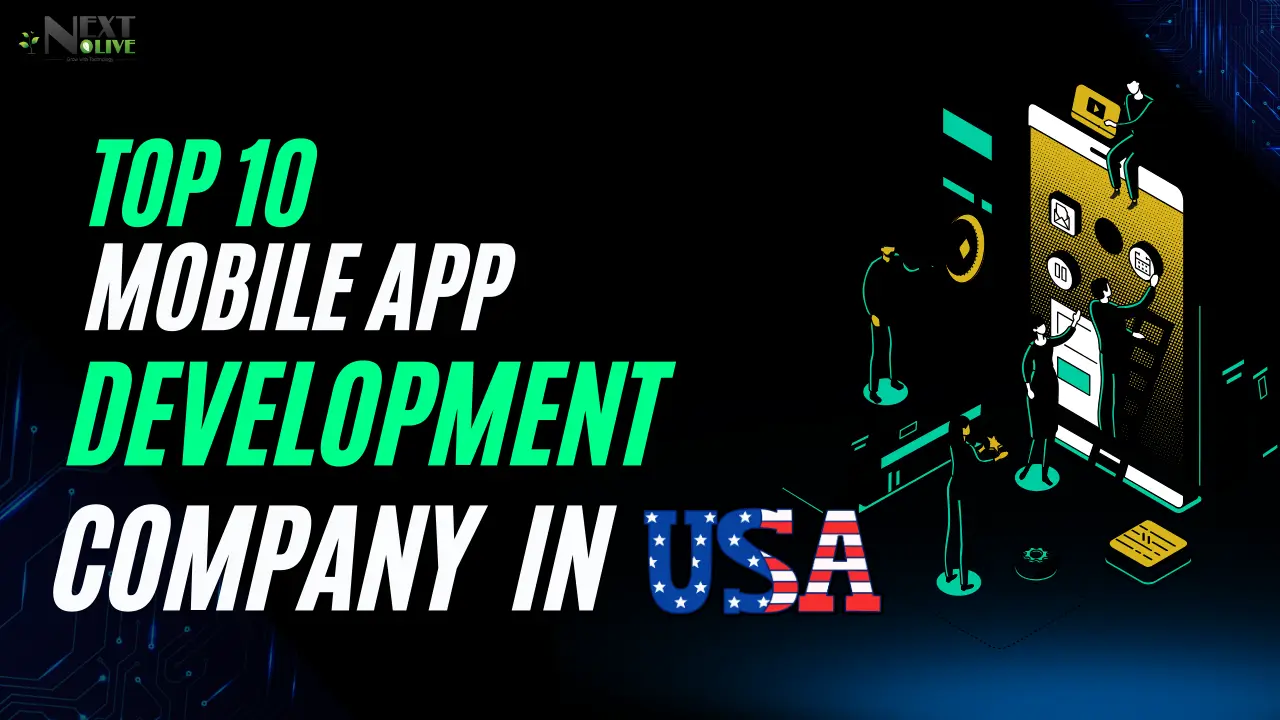What is Hybrid Mobile Application Development?
Hybrid app development is a process of native mobile application development that supports running across multiple operating systems within one codebase. These apps are designed by using web technologies, such as HTML5, CSS, and JavaScript, with a native shell that lets these applications run natively on both Android and iOS Platform.
Table of Contents
ToggleHybrid apps not only bridge the gap but are extensively made and are thus platform-specific, and also in the form of web apps that run inside the browser. They are mainly made using frameworks like React Native or Flutter to give a close-to-native experience at price-effective money and saving time.
In a fast-changing world of mobile technology, the exact need for business app development meets user demands on both platforms efficiently. In digital life, where application usage has become indispensable for growth, hybrid app development is a popular strategy in terms of native and web application development. Let us see the detailed description of hybrid app development and its various factors.
Characteristics of Hybrid Apps
Hybrid applications combine the versatility of web apps with the added functionality of a native app and hence are one of the popular choices for businesses across industries. Many characteristics make a hybrid application unique. Some of them are:
[1] Single codebase
Hybrid apps are developed using a unified codebase that allows the building of the same application for different platforms.
[2] Multisystem compatibility
Hybrid apps have reliable and robust Android and iOS compatibility due to their single codebase.
[5] Access Native Features
Hybrid apps will be able to perform device-specific features like accelerometers, cameras, and geolocation services using the use of plugins such as Cordova or Capacitor to provide rich functionalities.
[6] Scalability
Hybrid apps can often turn out to be a cost-effective solution for businesses looking forward to scaling their operations in multiple markets. With a single hybrid app, it can reach out to users across different platforms and devices.
Why choose Hybrid app development?
Among native, web, and hybrid applications, several businesses take on hybrid mobile app development because of its exceptional benefits. Given below are the reasons why hybrid application development has gained so much popularity:
[1] Cross-Platform Reach
Hybrid apps enable developers to build a single code base that can run across various platforms like Android and iOS. This allows its feature to promise a larger reach and saves much development effort.
[2] Cost Effectiveness
Native iOS as well as native Android apps are costlier to build. Hybrid apps avoid the necessity of developing various groups for the reason of both iOS as well as Android, thereby reducing the overall cost of development without losing any functionality.
[3] Rapid Development
A hybrid app develops faster than native apps due to a single codebase for all platforms. Hence, a business may get an opportunity to hit the market quicker than today’s requirements.
[4] Effortless User Experience
A hybrid app utilizes a rich framework to offer a hybrid native and web application experience that means a stable and engaging interface across devices.
[5] Accessing Native Features
Hybrid apps will make it possible to use device-specific features like accelerometers, cameras, and geolocation services with the usage of plugins such as Cordova or Capacitor to provide rich functionalities.
[6] Scalability
Hybrid apps can often be a cost-effective solution for businesses looking at scaling their operations across various markets. With a single hybrid app, it can reach out to users across different platforms and devices.
Hybrid app development services bring the business companies closer to achieving a performance-cost-user experience balance.
Different Hybrid application frameworks
Frameworks define the performance, scalability, and functionality level a hybrid app can achieve. The best hybrid mobile app development framework is that which best suits the complexity of the project, budget, and target audience. Now, let’s have an overview of the best hybrid mobile app frameworks for 2024:
[1] Hybrid App Development Using React Native
Developed by Meta, previously known as Facebook, React Native is the developers’ favorite for creating hybrid native apps. The technology allows developers to use JavaScript with good performance to create native-like interfaces.
[2] Flutter Hybrid App
The best hybrid mobile app development service option is Google’s Flutter. Based on Dart, Flutter enables developers to create beautiful apps on Flutter with native-like performance. The hot reload of Flutter accelerates the development process making it ideal for MVPs and scalable apps.
[3] Ionic
Of all the options, Ionic stands out as the best fit for the hybrid application development framework of web apps and is very popular in mobile app development with stunning responsive designs. It is perfectly compatible with Angular, React, or Vue.js and supports an exhaustive range of plugins for native devices.
[4] Cordova
Apache Cordova is one of the hybrid frameworks that is the oldest and most trusted. It has been around for quite a while, and web developers can use it to create apps that access native features via plugins.
[5] Xamarin
Another great solution is Xamarin, which was developed by Microsoft as a cross-platform mobile development platform. This allows programmers to create cross-platform apps using native UI components and offers the best user satisfaction and performance.
How to Build a Hybrid App: A Step-by-Step Approach
Hybrid app development needs proper planning, and more attention needs to be given to its execution and testing. Here’s a step-by-step guide on how to create a hybrid mobile application:
[1] Ideation and Conceptualization
The development process begins by examining the client’s vision, objectives, and target audiences. It is the point at which business goals intersect with user needs. Through market research of competitors, trends, and opportunities, the app’s core functionalities and features are defined.
[2] Requirement Gathering & Analysis
This step aggregates all detailed functional and non-functional requirements from the stakeholders. Some include understanding the technical specifications to deliver what the user expects and to make the desired output. Overall analysis ensures that a clear vision related to the client and the constraints of the project are well defined, which enables accurate planning and resource allocation.
[3] UI/UX Design & Prototyping
With requirements in hand, the design team begins building user-friendly wireframes, high-fidelity mockups, and interactive prototypes. This visual representation ensures that the app’s design is in line with user expectations and business branding. Feedback loops with stakeholders also refine the design so that the product’s user experience gets better and better.
[4] Development & Framework Selection
During this phase, the technical team selects the right frameworks, for instance, React Native or Flutter. This stage ensures perfectly smooth cross-platform functionality. The development of core features related to user authentication, integrations, and database setup is done. During the agile development process, it is ensured to complete the tasks during sprinting and developing the product. This causes timely updates and regular adaptability.
[5] Quality Assurance and Testing
It undertakes thorough testing to ensure no bugs, usability issues, and performance concerns. The QA test is conducted both manually and automatically on multiple devices and platforms. In this stage, functional, regression, and performance testing are done so the app can be launched smoothly under real-world conditions.
[6] Deployment & Store Submission
After it has been tested and finalized, the app is ready to be deployed. It is submitted to the App Store and Google Play Store for review and approval. Everything from descriptions on the app stores to actual performance will be optimized by the deployment team for a seamless launch.
[7] Post-Launch Support & Maintenance
After the launch, continuous monitoring is critical in identifying problems and gathering feedback from users. Regular updates are released to address bugs, enhance performance, and add new features. Maintenance ensures that the application will be compatible with the latest versions of the OS and continue to provide value to its users.
Benefits of Hybrid Mobile Application Development Services
Collaboration with a seasoned hybrid application development company offers many benefits:
[1] Cost Effective
Hybrid apps save development costs because it does not need platform-specific apps due to its single codebase feature.
[2] Time Saver
Hybrid applications can be developed and deployed much faster compared to native applications because they use one codebase.
[3] Bigger Market Coverage
With one hybrid application, the expectation is to reach a user base of different platforms, thereby maximizing audience coverage.
[4] Easier Maintenance
Updates and maintenance are much easier because the change on the codebase automatically replicates to all supported platforms.
[5] Consistency in Experience
Hybrid applications make sure that the user experience is uniform, thus enhancing brand credibility and recognition within the industries.
[6] Scalable Solutions
Hybrid applications are very excellent for companies that see a future potential of penetrating new markets or targeting other audiences.
Hybrid App Limitations
Hybrid app development, however, has some constraints that business enterprises should be aware of:
[1] Performance limitation
Hybrid apps can run somewhat slower than native apps, especially graphics-intensive applications like gaming.
[2] Native functionality for applications
Though plugins can make all the difference, hybrid apps have challenges in accessing native device features as is the case with native apps.
[3] UI/UX Issues
Hybrid apps on both Android and iOS are challenging to develop like native applications.
[4] Dependence on Third-Party Plugins
Hybrid apps highly depend on third-party plugins, which can be risky if they are not well maintained.
[5] Security Bugs
Hybrid applications tend to have more security problems as compared to the native ones.
Native vs. Hybrid Apps: Key Differences
The choice between native and hybrid apps would decide the performance, development time, cost, and user experience for the developers. Here’s a breakdown of the key differences:
[1] Development
Native Apps:
- Developed specifically for one platform (iOS or Android) using platform-specific languages (e.g., Swift for iOS, Kotlin/Java for Android).
- Requires separate development for each platform, increasing time and cost.
Hybrid Apps:
- Built using web technologies (HTML, CSS, JavaScript) and run inside a native wrapper.
- Usually utilize frameworks such as React Native, Flutter, or Ionic.
- May be created only once and then deployed on the two platforms: iOS and Android – to reduce development time and cost.
[2] Performance
Native Apps:
- Normally perform much better since they are natively optimized and directly access native device APIs
- Provide a smoother, faster, and more responsive experience specially for resource-intensive applications such as games or real-time applications.
Hybrid Apps:
- Tend to be less performant than native apps since they need to interact with the device through an abstraction layer that can slow things down, and rely on a web view.
- However, hybrid app performance has become significantly improved with frameworks like Flutter and React Native.
[3] UX
Native Apps:
- Native apps have better UX because they are designed to blend fully with the operating system and respect the specific design guidelines of the platform like Material Design for Android, and Human Interface Guidelines for iOS.
- Fluidity and intuitiveness in interaction; the power of the device hardware can be unleashed.
Hybrid Apps:
- Lastly, it may not necessarily feel as smooth and fluid as native experiences.
- There could be limitations based on the native feature set and the hybrid framework being followed that may impact the responsiveness and the integration with the device.
[5] Cost of Development
Native Apps:
- Higher development cost because each platform requires a separate code base.
- Ongoing costs also could be higher with platform-specific updates and bug fixes that might not be compatible.
Hybrid Apps:
- Lower Development Costs: Because only one code base requires development.
- Fewer bugs and faster updates on all platforms mean fewer long-term costs.
[6] Access to Device Features
Native Apps:
- All features of the device are available for use in native apps including camera, GPS, sensors, etc.
- The latest features and updates from the platform are immediately deployable.
Hybrid Apps:
- Access to device features using plugins or APIs; may not support all the device features in a very reliable and timely manner as in the native apps.
- May entail updating the hybrid framework and plugins to support newer device features.
[8] Approval by the App Store
Native Apps:
Relatively Subjected to More Comprehensive Review Processes, since native apps are proprietary to one platform or environment but may leverage specific native features of either the App Store or Play Store.
Hybrid Apps:
They may have a problem with app store approvals when they fail to meet specific performance or design requirements. On the other hand, if they meet the general standards, then they will likely pass approval smoothly.
[8] Examples
Native Apps: Facebook, Instagram, Snapchat (built for specific platforms).
Hybrid Apps: Airbnb, Instagram in the past, and Uber initially built in hybrid
On a final note
This is an ideal solution for applications that require better performance, utilize the device, and offer an ultimate user experience. Hybrid apps are the perfect solution for rapid development or cost-effective application building, especially when targeting both iOS and Android at once from a single code base. It would all depend upon the project requirements or needs specific to budgeting, timeline, performance requirements of the application, and the targeted audience.
Hybrid Apps Examples
Hybrid development has been adopted by many companies to reach all over the world:
[1] Instagram: Web-based content with a native wrapper for a flawless performance.
[2] Uber: A reliable hybrid application for real-time ride booking.
[3] Twitter: Native performance with flexibility to web-based performance.
[4] Evernote: Hybrid application that provides heavy productivity tools.
Future of Hybrid Application Development
Hybrid app creation promises much and is influenced by several trends as summarized below.
[1] AI Integration: Hybrid applications will employ AI to present users with more personalized experiences
[2] 5G Rollout: Faster networks will improve hybrid app performance and responsiveness.
[3] Improved Frameworks: Hybrid app frameworks such as Flutter and React Native will continue to develop, addressing performance gaps.
[4] PWA Convergence: Hybrid applications and PWAs will come closer, giving companies more flexible solutions.
Conclusion
Hybrid application development is one of the perfect options in 2024 for every type of Business that could give organizations the best balance of cost, efficiency, and user experience. With the appropriate hybrid mobile development platforms and frameworks, companies can create scalable and fast-running applications under today’s demands. Whether it is a startup or an enterprise, a trusted hybrid mobile application development company will ensure the success of your project. What has been noticed in terms of improvement of technology and frameworks, exciting developments are envisioned for the future of hybrid app development.
Frequently asked questions (FAQs)
Next Olive Technologies is the foremost hybrid development company that has over 100 hybrid app developers. Some other hybrid mobile app development companies are Appinventiv, Sciencesoft, etc.
Companies generally offer app development, mobile consulting, app migration, web app development, etc services.
The cost of developing a hybrid app depends upon the type and complexity of the app. Here is a general cost of different types of hybrid applications:
Small app: $5,000 to $10,000
Medium app: $10,000 to $200,000
Large app: Above $200,000








